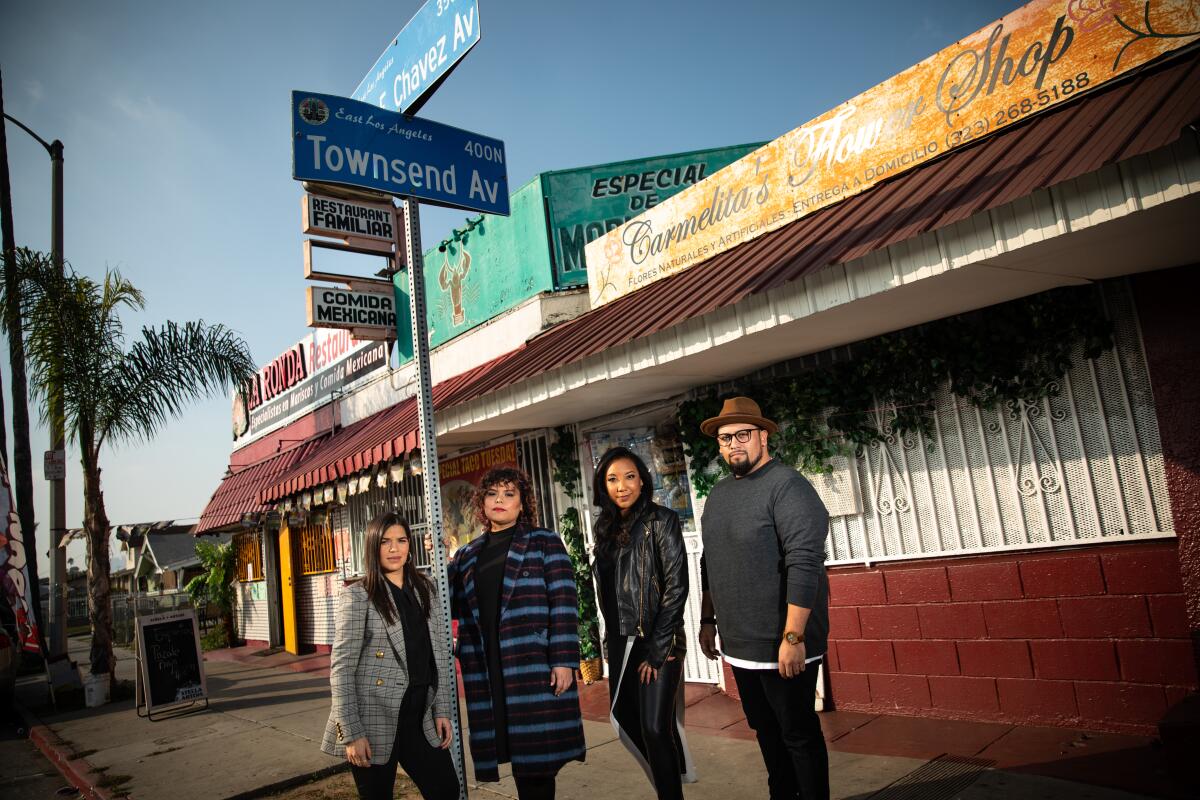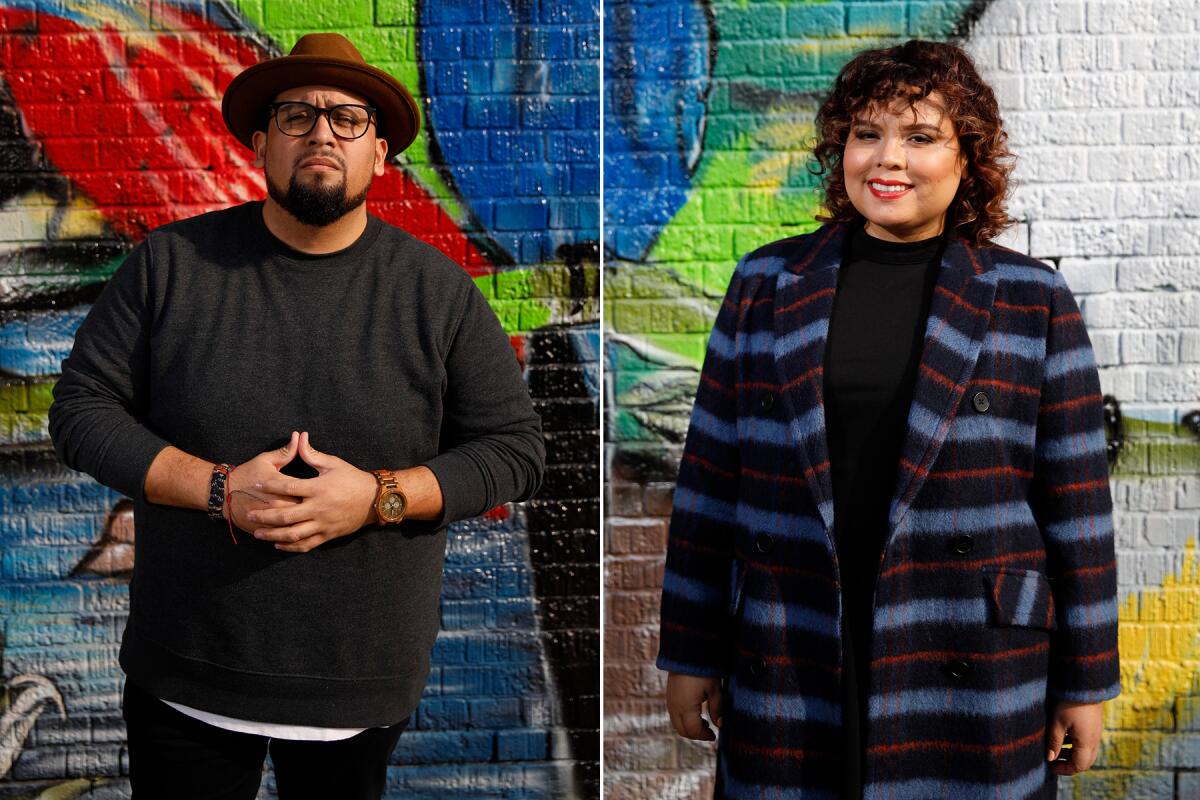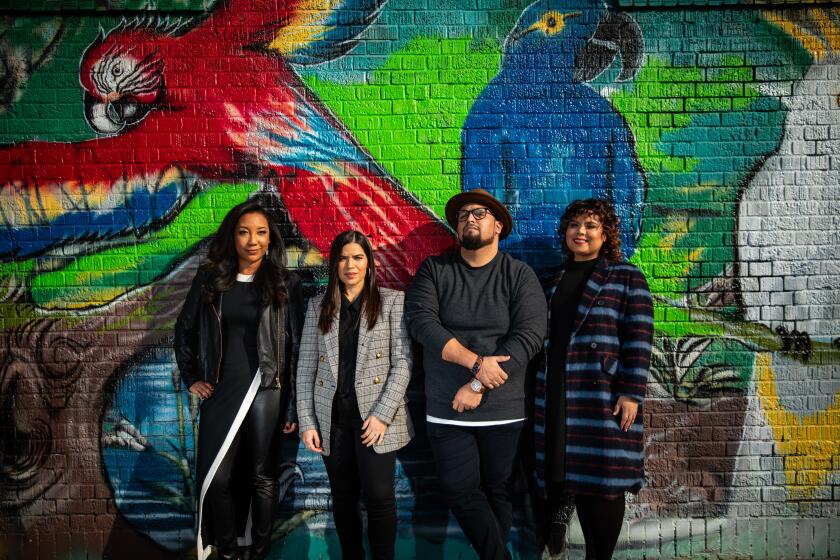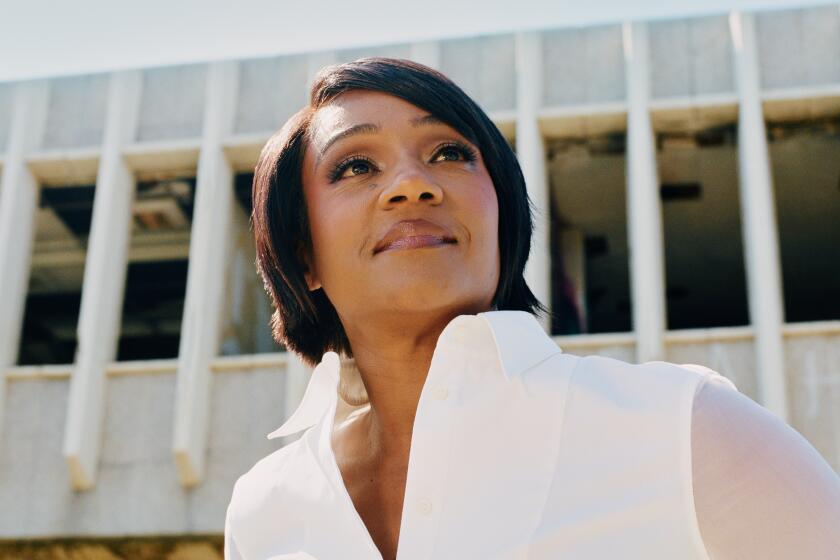A Netflix series tackles gentrification in L.A. Some say it’s part of the problem

Netflix’s new series “Gentefied” explores the gentrification battles that have roiled Boyle Heights in recent years. But the story of how the series came to be starts a few miles northwest, in East Hollywood.
For the record:
4:13 p.m. Feb. 6, 2020A previous version of this story misidentified the restaurant at the intersection of Cesar E. Chavez and Townsend avenues as Taqueria La Que Si Llena. It is La Ronda Restaurant.
Co-creator Marvin Lemus moved into a studio apartment there roughly five years ago, looking for a sense of home in the predominantly working-class Latino neighborhood after graduating from the Art Institute of California. The Mexican and Guatemalan American writer-director-producer hails from Bakersfield, where he felt like he never really belonged. But the comforts he found in East Hollywood couldn’t obscure the fact that new businesses were sprouting up and more affluent people were moving into his apartment complex, replacing others priced out by rising rents and the higher cost of goods.
And he quickly found himself confronting his own part in the neighborhood‘s transformation.
“An elotero would come by every day — it felt so much like home in a way that I hadn’t experienced in a while,” Lemus says. “But I started to realize that even though this is how I grew up, even though this feels like the home I was seeking, I am a part of the change that’s coming into this neighborhood. I’m in a different tax bracket. I’m in a different situation than the family of four living in the studio apartment next door. It messed with me.”
That internal conflict, and the desire to engage the nuances of a thorny civic issue, became “Gentefied.” (The show’s title is a play on the term “gentefication,” in which young, upwardly mobile Latinos move back or try to give back to their old neighborhoods.)

The Morales primos love their culture, community and family. But what happens when you have to choose between them? “Gentefied” premieres February 21 on Netflix.
Making its debut Feb. 21, the 10-episode first season revolves around the Morales family: three Mexican American cousins — Erik (Joseph Julian Soria), Chris (Carlos Santos) and Ana (Karrie Martin) — and their immigrant grandfather (Joaquín Cosio) who find themselves trying to save the family’s taqueria as gentrification knocks on their neighborhood‘s door. The half-hour Spanglish dramedy is an extension and adaptation of the 2017 short-form web series of the same name.
The series arrives as Boyle Heights, the working-class, heavily Latino enclave east of downtown L.A., has become a gentrification battleground in recent years, with locals contending with an influx of coffee shops and art galleries, new real estate developments and surging rent and home prices, as interested tenants with deeper wallets flock to the area. Some longtime residents embrace what’s gained from the change, while others are angered over what is lost from their beloved community because of it.
Over tacos dorados and Mexican Coke inside La Ronda Restaurant on the corner of the bustling East L.A. intersection of Cesar Chavez and Townsend avenues, which serves as the fictional taqueria featured in the show, Lemus, along with fellow co-creator Linda Yvette Chávez, executive producer America Ferrera and showrunner Monica Macer, describes the power of showing the neighborhood and its beauty in a light that is rarely seen on TV. And the importance of putting a human face on the collision of views.
“Gentefied” premiered as a web series at the Sundance Film Festival in 2017. This year, it’s returning as a highly anticipated Netflix dramedy.
“We’re not going to pretend to have answers,” Lemus says. “The show has the older generation, the immigrants and the first-gen kids ... and everybody has a different perspective on the things ...”
“And everyone is right in their own way,” adds Chávez, whose family emigrated from Mexico to Boyle Heights. “We want people to have a deeper understanding of gentrification and its impact, especially when it comes to Boyle Heights. That’s a community that loves itself so much, enough to fight for it, and that is so proud of its history. It’s such a beautiful thing.”
One episode of the series includes a protest scene outside the taqueria that, Macer says, had locals convinced it was real.
“People were like beeping their car horns, like showing their solidarity against gentrification,” Macer says. “You got a sense of the community empowerment.”
For Ferrera, gentrification, particularly gentefication, is the physical manifestation of the inner struggle of children of immigrants who are living between worlds.
“I’ve spent my whole life, and certainly my whole career, trying to understand,” she says. “What claim do I have to be Latina if I’m a Valley girl raised in Woodland Hills and all my friends were Jewish and I went to 32 bar mitzvahs and not a single quinceañera? Am I really allowed to say I’m Latina?
“I have identified as an American my whole life and yet, when people look at me, and particularly in this moment in our country’s history, no one looks at me and doesn’t see my skin color,” she continues. “So for all of us that equation looks different between how much was accepted by our Latino community, how much is rejected, and then how much of ourselves we’ve had to strip away or leave behind so that we could fit in and succeed and ultimately achieve the dreams that our parents brought us here to achieve.”

“Gentefied” isn’t the first TV show to explore gentrification in recent years — “Insecure,” “One Day at a Time,” “The Last O.G.” and “The Neighborhood” are among the series to devote screen time to the issue. But like Starz’s “Vida,” also set in Boyle Heights, “Gentefied” has made the polarizing topic a driving force of its narrative.
The series is launching at a time when Latino representation in Hollywood remains abysmal despite Latinos being the largest nonwhite demographic in the U.S. Los Angeles Mayor Eric Garcetti recently announced the creation of LA Collab, an initiative in the entertainment industry to double the representation of Latinos in Hollywood by 2030. And though Netflix disappointed a contingent of viewers last year when it canceled its Latinx reboot of “One Day at a Time” — since saved by Pop TV — it’s hoping to redeem itself with “Gentefied.”
“There is a dearth, which is why it’s important to us to keep making shows that reach and reflect the Latinx audience,” says Jane Wiseman, vice president of original series at the streamer, by phone. Wiseman noted that the show will premiere alongside the launch of Netflix’s new social channel, Con Todo, which will celebrate Latinx creators and talent much as its other social channel Strong Black Lead has done.
“Gentefied” was shot on a soundstage at L.A. Hangar Studios in Boyle Heights. But the series also pointed its cameras around the area — venturing to locations such as El Mercado and Mariachi Plaza along 1st Street, and Plaza de la Raza on Mission Road in Lincoln Heights.
That on-the-ground experience has made Macer, whose credits include “Queen Sugar” and “The Breaks,” more aware of the role she and the series might play in not only chronicling gentrification but also contributing to it.
“When we would film at certain locations, we were very aware of wanting to keep our footprint as low as possible,” she says. “It would make me think twice because I’m like, ‘Am I helping or am I hurting?’ We always want to be an ally and an advocate. So, yeah, when we’re shooting somewhere, or even doing this interview here, there are thoughts about: Are we displacing another customer that could be a regular? We’re not just trying to take, take, take. We’re trying to give back.”
Lemus and Chávez say they’ve been building ties within the community since working on the web series, which they primarily wrote at Primera Taza Coffee House on 1st Street. (It has since relocated to the Arts District.) Producers and the show’s writers spoke with community groups in meetings facilitated through Harness, a nonprofit organization founded by Ferrera, her husband, Ryan Piers Williams, and actor Wilmer Valderrama, in an attempt to get things right. The group also took a tour of the neighborhood before work began on the first season.
And the premiere event for the series will be held at Plaza de la Raza. Producers, with help from Netflix, are also trying to finalize screenings at various local colleges to foster a dialogue.
“The minute we learned about the degree of activism going on in Boyle Heights, we were very intentional about trying to get to know people, talk to people as much as we could,” Chávez says. “We went into it with letting people know like, ‘Hey, first of all we’re not here to speak for you all.’ ... The intention has always been telling a story that illuminates something most of us ignore.”
But ahead of its premiere, the show already has its detractors. In a Facebook post last fall, anti-gentrification group Defend Boyle Heights suggested that those involved with the series are profiting from the the struggles of those trying to fight against changes to their neighborhood.
“GENTEFIED STAY OUT OF BOYLE HEIGHTS,” the post starts. “Lemus and Chávez, the show’s creators, claim that Gentefied is ‘a love letter to the Latinx and Boyle Heights communities.’ We know this isn’t further from the truth. They cannot come into Boyle Heights and appropriate our struggle against gentrification and then claim love for the very community they are stealing from.”
A member of the group, which has previously protested the production of “Vida” in the neighborhood, appeared on a Sundance Institute panel for the “Gentefied” web series in 2017, praising Lemus and Chávez for their engagement with the community.
Defend Boyle Heights did not immediately respond to a request for further comment.
Veronica Polanco, president of the Boyle Heights Neighborhood Council and a longtime resident of the community, hopes the show will feel authentic. She acknowledges that it’s a conundrum for residents who want their stories to be told and for the neighborhood to be highlighted but, at the same time, don’t want to be used as a token example of inequality and a catch-all for Latino-ness.
“There’s always the concern of, ‘Are we going to be the joke? Are they going to get us right? Are they going to get the neighborhood right?’” Polanco says. “Just from what I’ve seen from the trailer, so far, it does feel like it’s trying to be genuine to who we are as a community. Not only are they addressing the issues that are very prominent in our neighborhood, but they have [done] it with a sense of humor that we use when dealing with our everyday issues.”
“Many people seek Boyle Heights as a means of gaining authenticity,” Polanco added in a follow-up email. “It can be frustrating, but as I see so many neighborhoods in Los Angeles losing their culture identity, I see why people are gravitating toward us. We have and will continue to hold on to the beautiful thing we have — our gente. We are still a community of working-class people, a community of immigrants, a community of beautiful stories and experiences.”
‘Gentefied’
Where: Netflix
When: Anytime, starting Friday, Feb. 21
More to Read
The complete guide to home viewing
Get Screen Gab for everything about the TV shows and streaming movies everyone’s talking about.
You may occasionally receive promotional content from the Los Angeles Times.








